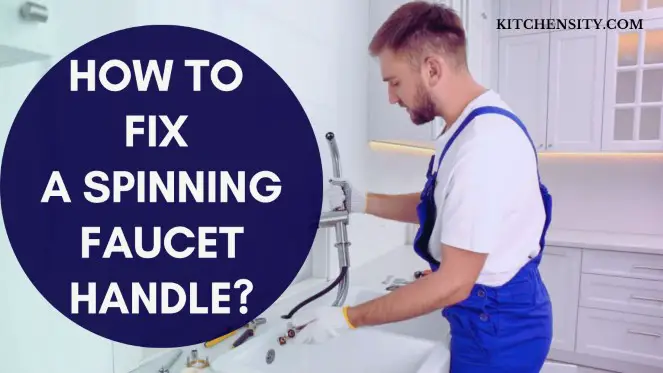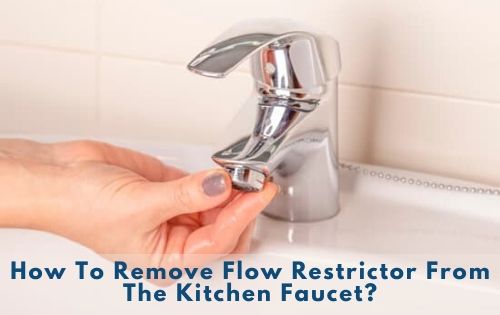When it comes to plumbing tasks, having the right tools can make all the difference.
One essential tool for working with faucets and other plumbing fixtures is a basin wrench.
However, there may be instances when you don’t have a basin wrench readily available or prefer to use an alternative tool.
In this article, we will explore various alternatives to the basin wrench, their functionalities, benefits, and limitations.
So, let’s dive in and discover the versatile options you can use as a basin wrench alternative.
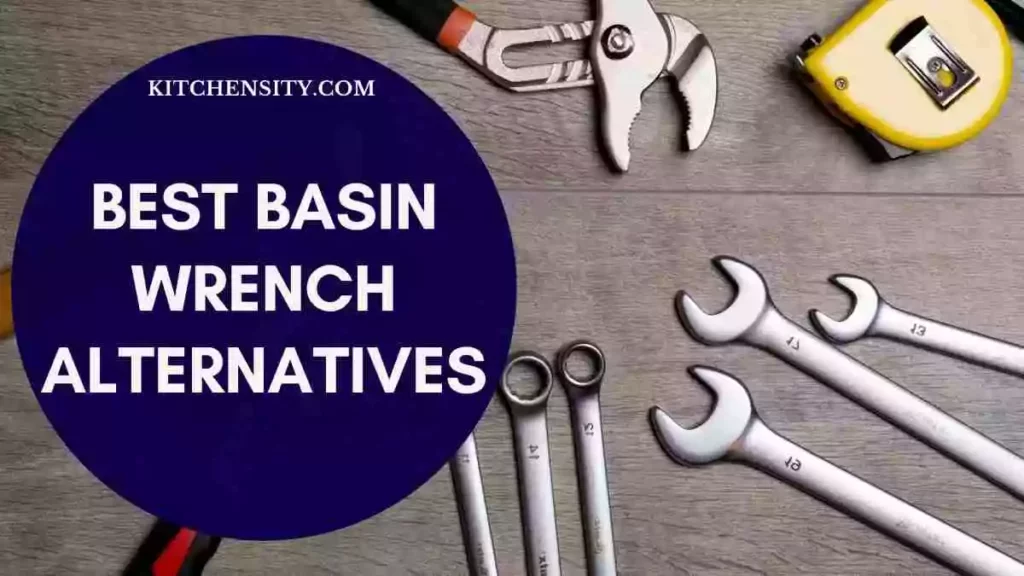
Table of Contents
- 1 What Are Basin Wrench Alternatives?
- 2 The Importance Of Plumbing Tools
- 3 The Purpose Of A Basin Wrench
- 4 Best Alternatives Of Basin Wrench
- 5 Adjustable Wrench
- 6 Locking Pliers
- 7 Strap Wrench
- 8 Pipe Wrench
- 9 Monkey Wrench
- 10 Combination Wrench
- 11 The DIY Basin Wrench Method
- 12 Can You Change A Faucet Without A Basin Wrench?
- 13 Is A Basin Wrench The Same As A Pipe Wrench?
- 14 Conclusion
- 15 YOU MAY ALSO LIKE
- 16 FAQs
- 16.1 Can I Use Any Wrench As A Basin Wrench Alternative?
- 16.2 What Factors Should I Consider When Choosing A Basin Wrench Alternative?
- 16.3 What Can I Use If I Don’t Have A Faucet Wrench?
- 16.4 Are There Any Specific Tips For Using An Adjustable Wrench As A Basin Wrench Alternative?
- 16.5 Which Alternative Is Best For Tight Spaces?
- 16.6 How Can I Ensure I Don’t Damage The Plumbing Fixtures?
What Are Basin Wrench Alternatives?
When seeking alternatives to a basin wrench, consider the versatility of tools such as an adjustable wrench, locking pliers, strap wrench, or pipe wrench. Additionally, a monkey wrench or combination wrench can provide viable alternatives. If you prefer a DIY approach, you can create a basin wrench using scrap metal or PVC pipe shaped into a T-shape.
Each option offers its advantages, so choose the method that suits your needs and the specific plumbing task at hand.
Refer below for a comprehensive guide on its alternatives.
Also Read – How To Remove Kitchen Faucet Without Basin Wrench?
The Importance Of Plumbing Tools
Before we dive into the problems with basin wrenches, let’s take a moment to appreciate the importance of plumbing tools.
Plumbers rely on these tools to fix leaky pipes, install new fixtures and appliances, and maintain the overall integrity of plumbing systems.
Without these specialized tools, plumbers would be unable to do their jobs efficiently or effectively.
The Purpose Of A Basin Wrench
A basin wrench is a tool used specifically for tightening or loosening nuts in tight spaces under sinks and other confined areas.
It typically consists of an adjustable head with serrated jaws that grip onto nuts securely for easy turning without slipping off during use.
Also Read – Low Water Pressure In The Kitchen Sink: How To Fix It?
The Common Issues With Using A Basin Wrench
While basin wrenches are useful for some tasks, they can also be frustratingly difficult to use at times.
- For starters, they require precise positioning to work correctly and this can prove challenging when working in tight spaces where visibility is limited.
- Furthermore, they are relatively bulky compared to other plumbing tools like adjustable wrenches or channel locks which makes them cumbersome to use in certain situations.
- Another issue I’ve encountered with basin wrenches is their tendency to slip off nuts during use which can damage both the nut and surrounding plumbing fixtures in the process leading to costly repairs down the line.
- Due to its design limitations and inflexibility compared to other plumbing tools, a basin wrench can only be used for a limited range of tasks and is not suitable for use in all plumbing situations that require the tightening or loosening of nuts.
Also Read – How To Fix A Faucet Handle That Turns Too Far?
Best Alternatives Of Basin Wrench
Adjustable Wrench
- An adjustable wrench is a versatile tool commonly found in many toolboxes.
- With its adjustable jaw width, it can accommodate various sizes of nuts and bolts.
- While it may not have the specialized design of a basin wrench, an adjustable wrench can be used effectively in some plumbing tasks.
- When using an adjustable wrench as a basin wrench alternative, ensure a snug fit on the fixture’s nut.
- The adjustable wrench allows you to apply the necessary torque to loosen or tighten the nut.
- However, it’s important to note that the adjustable wrench may not provide the same level of convenience or reach as a dedicated basin wrench.
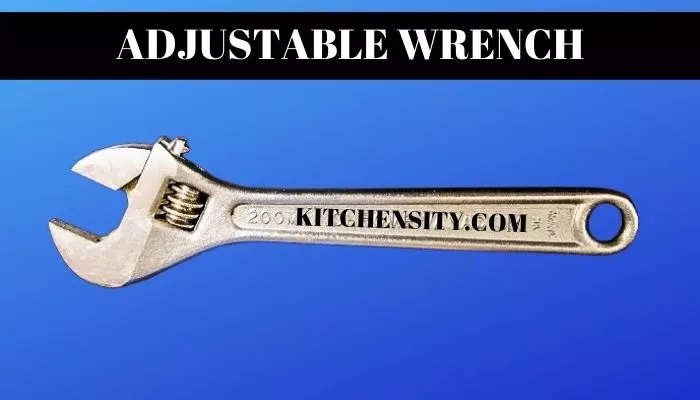
To use this method, simply adjust the jaws of your trusty adjustable wrench to fit snugly around the nut or bolt that needs turning. Use one hand to hold the fixture in place while you turn the wrench with your other hand.
It’s that easy! But before you run off to try this method for yourself, let’s go over some pros and cons
You May Also Like: 6 Pull Out Spray Kitchen Faucet Problems
PROS
- It’s a tool that many people already have in their toolboxes, so there’s no need to make an extra purchase.
- Additionally, an adjustable wrench can fit into tight spaces that a basin wrench might not be able to reach.
- It is a user-friendly tool, making it accessible to both professionals and DIY enthusiasts.
- The adjustable wrench has a simple design with a movable jaw and a thumbwheel for adjustment, making it easy to find the right size and tighten or loosen fasteners.
CONS
- On the downside, using an adjustable wrench requires more effort than using a basin wrench since it requires two hands instead of one.
- Additionally, if the jaws of the adjustable wrench aren’t adjusted properly or are worn down, they may slip and damage the fixture or even injure you.
Overall, adjustable wrenches are versatile and widely available tools that can be used for various tasks.
However, they may lack the specialized grip strength and precision of dedicated wrenches, and their bulkiness can pose challenges in certain situations.
Proper technique and care should be exercised to avoid damage and ensure optimal performance.
Also Read – How To Lubricate A Swivel Faucet?
Locking Pliers
- Locking pliers, also known as Vise-Grips, are known for their strong grip and locking mechanism.
- They can be an excellent alternative to a basin wrench, particularly when dealing with stubborn nuts or bolts.
- Locking pliers feature an adjustable jaw that clamps onto the object securely, allowing you to exert significant force.
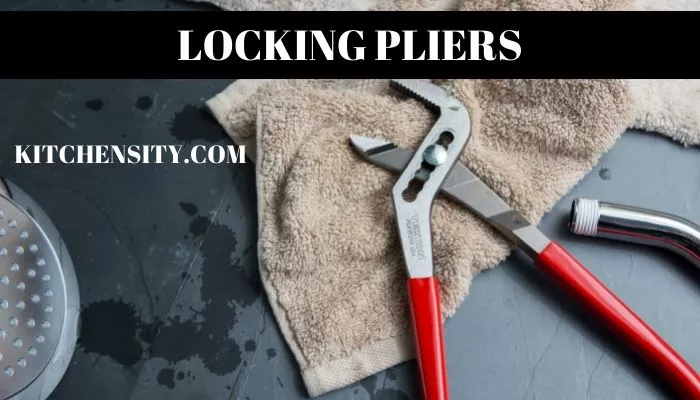
To use locking pliers as a basin wrench alternative, position the jaws around the nut and tighten the grip. The locking mechanism will hold the pliers in place, allowing you to apply torque to the nut.
However, due to the bulkier design, locking pliers may not be suitable for tight spaces or delicate fixtures.
You May Also Like: How to Unclog a Sink Clogged With Coffee Grounds?
PROS
- One advantage of using locking pliers is their ability to grip onto the fixture tightly, allowing for a secure hold without fear of slipping.
- Additionally, locking pliers can be used for various tasks around the house, making them versatile tools to have on hand.
- Locking pliers have an adjustable jaw opening, which means you can adapt them to fit different sizes of nuts, bolts, or other objects.
CONS
- On the other hand, locking pliers require two hands to operate and may not be as accessible as an adjustable wrench or basin wrench.
- Furthermore, if the fixture is particularly stubborn or hard to reach, locking pliers may not be the best option.
- Locking pliers may have a bit of a learning curve, especially when it comes to unlocking and releasing them. It may take some practice to become proficient in using them effectively and efficiently.
Also Read – How To Fix A Stiff Kitchen Faucet?
Strap Wrench
- A strap wrench is a versatile tool that utilizes a strap or chain to grip objects.
- It is particularly useful when dealing with smooth or delicate surfaces, as it doesn’t leave any marks or scratches.
To use a strap wrench as a basin wrench alternative, wrap the strap around the nut or fitting and secure it in place. Then, turn the handle to apply torque and loosen or tighten the nut. The strap’s grip distributes pressure evenly, making it suitable for fragile fixtures.
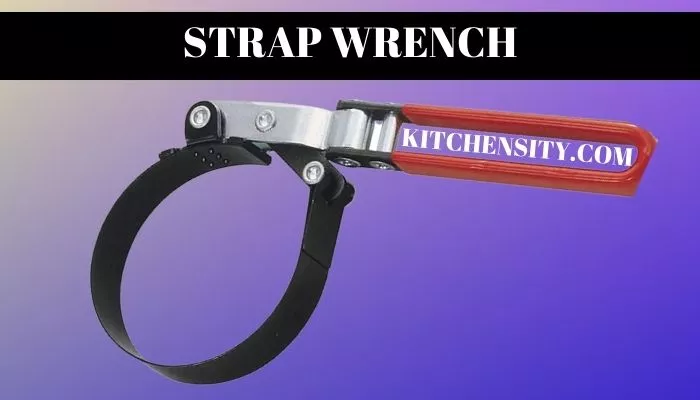
Additionally, the strap wrench’s adjustable strap allows it to accommodate various sizes of nuts or fittings.
Also Read – How To Fix A Spinning Faucet Handle?
PROS
- Strap wrenches can generally fit into tight spaces and are less likely to cause damage to fixtures or pipes.
- Its adjustable strap allows you to fit it around objects of different sizes, making it suitable for various tasks.
- Strap wrenches are particularly useful when working with delicate surfaces, such as polished pipes or fragile fixtures.
CONS
- On the downside, pipe pliers and strap wrenches may not be as readily available as adjustable wrenches or locking pliers.
- Additionally, they may not offer the same level of precision and control as a dedicated plumbing tool like a basin wrench.
- Strap wrenches are typically designed for use in one direction only, usually for loosening objects.
Pipe Wrench
- A pipe wrench is a common tool used by plumbers to grip and turn pipes or pipe fittings.
- Its adjustable, serrated jaws provide a secure grip on round objects.
- While primarily designed for pipe-related tasks, a pipe wrench can also serve as a basin wrench alternative in certain situations.
When using a pipe wrench, position the jaws around the nut or fitting and apply pressure to secure a firm grip. The long handle of the pipe wrench provides leverage to loosen or tighten the nut effectively.
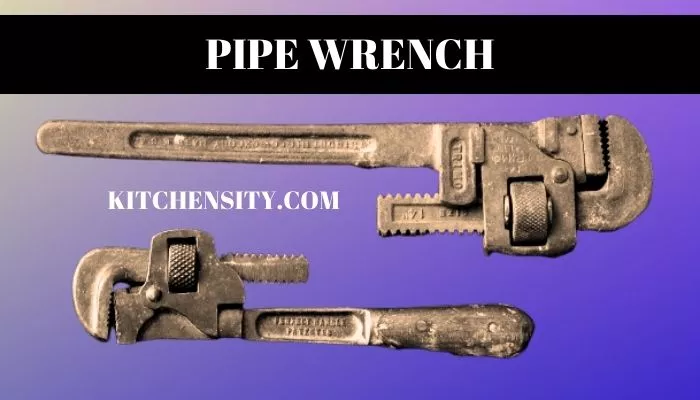
However, keep in mind that the serrated jaws of a pipe wrench can potentially damage the surface of the nut or fitting, so caution should be exercised.
PROS
- A pipe wrench is designed with serrated jaws that provide a strong and secure grip on pipes and fittings.
- It typically has an adjustable jaw capacity, allowing you to fit it around pipes of different sizes.
- A pipe wrench is made of sturdy materials such as cast iron or steel, which enhances its durability and longevity, making it a reliable tool for demanding tasks.
CONS
- The serrated jaws of a pipe wrench, while providing a strong grip, can leave marks or damage the surface of pipes or fittings.
- Its size and weight can make maneuvering and accessing certain areas more challenging.
- It may not be as effective or suitable for use on non-cylindrical objects or components with irregular shapes.
Monkey Wrench
- Similar to a pipe wrench, a monkey wrench is designed for gripping and turning pipes and fittings.
- It features smooth jaws that provide a secure grip without causing damage.
- While not specifically designed for plumbing fixtures, a monkey wrench can be used as a basin wrench alternative for certain tasks.

Simply position the smooth jaws around the nut and apply pressure to turn it. The adjustable nature of a monkey wrench allows you to adapt it to different sizes of nuts or fittings. However, like the pipe wrench, its size and bulkiness may limit its use in tight spaces.
Also Read – How To Remove Handle From Faucet?
PROS
- Its versatility makes it suitable for a wide range of tasks where you need to grip and turn different-sized nuts or bolts.
- Monkey wrenches have serrated jaws that provide a secure grip on objects, preventing slippage and allowing you to apply torque with confidence.
- It is usually made of robust materials such as steel, ensuring long-lasting performance and reliability.
CONS
- The serrated jaws of a monkey wrench, while providing a secure grip, can leave marks or damage the surface of nuts or bolts, especially if they are made of softer materials.
- It may not be as suitable for tasks that require access to tight spaces or involve specialized fittings or components.
Combination Wrench
- A combination wrench is a standard tool with an open-end wrench on one side and a box-end wrench on the other.
- While not specifically designed for plumbing tasks, it can be used as a makeshift basin wrench alternative in certain situations.
- The open-end wrench can be used to quickly loosen or tighten nuts, while the box-end wrench provides a more secure grip.
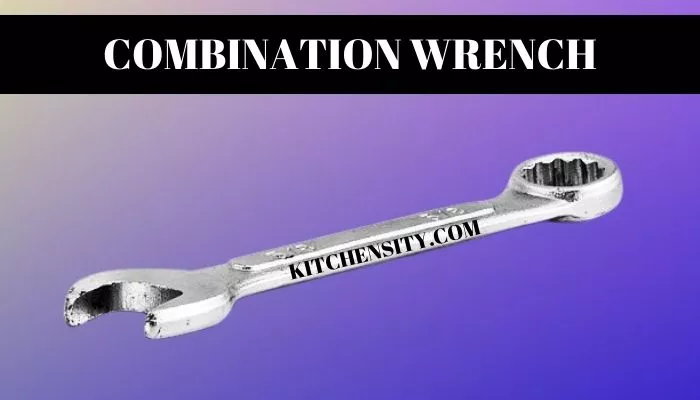
When using a combination wrench, ensure that the size of the wrench matches the nut or fitting. However, due to its limited reach and versatility compared to a dedicated basin wrench, a combination wrench may not be the ideal choice for all plumbing tasks.
You May Also Like: How To Unclog A Sink Clogged With Coffee Grounds?
PROS
- A combination wrench combines the features of an open-end wrench and a box-end wrench. This dual functionality allows you to tackle different types of fasteners.
- It can be used on a wide range of nuts, bolts, and fasteners, allowing you to work on multiple projects without needing multiple wrenches.
- Its compactness also makes it portable, so you can carry them in your toolbox or take them on the go.
CONS
- The bulky nature of the wrench head, especially on the box-end side, may restrict access to certain angles or tight spaces.
- Each combination wrench is designed to fit a specific size of fastener. This means you will need multiple combination wrenches or additional tools if you encounter different-sized fasteners during a project, which can be inconvenient.
The DIY Basin Wrench Method
For those who are feeling particularly handy and crafty, there is always the option of creating your homemade basin wrench alternative.
While it may seem daunting at first, this method can save you time and money in the long run.
To create your DIY basin wrench alternative, you’ll need some basic tools like:
- A hacksaw and pliers.
- And materials like scrap metal or PVC pipe.
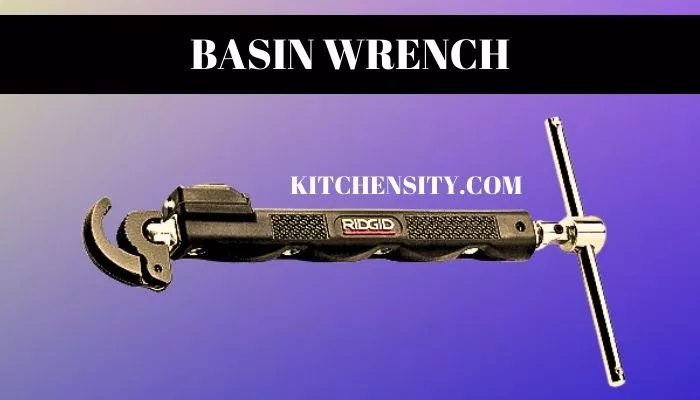
Steps to Create a DIY Basin Wrench:
Step 1: Prepare The Materials
Begin by gathering your materials, including scrap metal or PVC pipe. Ensure that the size of the material is suitable for your project.
Step 2: Cut The Material
- Using a hacksaw, carefully cut the scrap metal or PVC pipe to the desired length.
- It should be long enough to provide leverage and reach the plumbing fixtures you need to work on.
Step 3: Shape The Material
Using the pliers, shape one end of the metal or pipe into a T-shape. This end will be used to grip the plumbing fixtures securely.
Step 4: Test The Diy Basin Wrench
- With the T-shaped end of the material facing the plumbing fixture, grip the fixture with your newly created DIY basin wrench alternative.
- Hold the wrench securely with one hand while using your other hand to turn the fixture.
- Test its grip and ensure that it allows you to effectively turn the fixture.
Step 5: Make Adjustments If Necessary
- If needed, make any adjustments to the size or shape of the T-shaped end of the DIY basin wrench alternative.
- Ensure that it fits securely over the plumbing fixtures and provides a stable grip.
The advantage of creating your basin wrench alternative is that you can customize it to fit your specific needs and preferences. Additionally, this method can be cost-effective since you’re using materials that might otherwise go to waste.
However, creating your tool requires some degree of technical skill and patience.
If you’re not experienced in working with tools or shaping metal or PVC pipe, this method might not be for you.
Also Read – How To Remove Flow Restrictor From The Kitchen Faucet?
Can You Change A Faucet Without A Basin Wrench?
Changing a faucet is a common plumbing task that may require the use of a basin wrench.
However, if you find yourself without this specialized tool, don’t worry! There are alternative methods you can use to change a faucet without a basin wrench.
Method 1: Adjustable Wrench
One of the most readily available tools in many toolboxes is the adjustable wrench.
While it may not be specifically designed for plumbing tasks, it can serve as a viable alternative to a basin wrench.
Here’s how you can use an adjustable wrench to change a faucet:
- Turn Off The Water Supply: Before beginning any work on the faucet, make sure to turn off the water supply by closing the valves under the sink.
- Disconnect The Water Supply Lines: Use an adjustable wrench to loosen the nuts connecting the water supply lines to the faucet. Turn the nuts counterclockwise to loosen them and remove the lines.
- Remove The Mounting Nuts: Locate the mounting nuts holding the faucet. These nuts are typically located underneath the sink. Use the adjustable wrench to loosen and remove the nuts by turning them counterclockwise.
- Remove The Old Faucet: Once the mounting nuts are removed, you can lift the old faucet off the sink. Be careful not to damage any surrounding plumbing or fixtures.
- Install The New Faucet: Place the new faucet into the mounting holes on the sink. Ensure that the faucet aligns properly and sits securely.
- Secure The Mounting Nuts: Use the adjustable wrench to tighten the mounting nuts by turning them clockwise. Make sure the faucet is stable and doesn’t wobble.
- Reconnect The Water Supply Lines: Attach the water supply lines to the corresponding connections on the new faucet. Use the adjustable wrench to tighten the nuts by turning them clockwise.
- Turn On The Water Supply: Once all connections are secure, open the water supply valves under the sink to restore the water flow.
By following these steps and using an adjustable wrench as a substitute for a basin wrench, you can successfully change a faucet without the specialized tool.
Also Read – How To Fix A Leaky Kitchen Faucet?
Method 2: Other Tools
If you don’t have an adjustable wrench, other tools can be used as alternatives to a basin wrench.
These include locking pliers, pipe wrenches, and even a combination of regular pliers and a screwdriver.
While these methods may require a bit more improvisation, they can still get the job done.
Here’s a brief overview of how you can use these tools:
- Locking Pliers: Use locking pliers to grip and turn the mounting nuts or other components of the faucet. The locking mechanism will hold the pliers in place while you apply torque.
- Pipe Wrenches: Similar to locking pliers, pipe wrenches can be used to grip and turn the mounting nuts. The adjustable jaws provide a secure grip, but be cautious not to damage the nuts or surrounding fixtures.
- Pliers And Screwdriver: In some cases, you can use a combination of regular pliers and a screwdriver. Use the pliers to grip the mounting nut while using a screwdriver for additional leverage to turn the nut.
Remember to exercise caution and take your time when using alternative tools. It’s important to avoid damaging the faucet or surrounding plumbing fixtures.
Is A Basin Wrench The Same As A Pipe Wrench?
No, a basin wrench is not the same as a pipe wrench. While both tools are used in plumbing tasks, they have different designs and purposes.
- A basin wrench is a specialized tool designed specifically for working in tight spaces under sinks.
- It has a long handle with a pivoting jaw at the end.
- The pivoting jaw can be adjusted and positioned to reach and grip the nuts or fittings that secure faucets and other plumbing fixtures.
- The unique design of a basin wrench allows it to access hard-to-reach areas and provides leverage for loosening or tightening these nuts or fittings.
On the other hand:
- A pipe wrench is a more general-purpose tool used for gripping and turning pipes or pipe fittings.
- It has a larger and heavier construction compared to a basin wrench.
- Pipe wrenches have serrated jaws that bite into the surface of the pipe or fitting, providing a secure grip.
- They are commonly used by plumbers for tasks such as assembling and disassembling pipe connections.
While a pipe wrench can be used in certain situations as a basin wrench alternative, it is not specifically designed for the same purpose.
Basin wrenches are more suited for working on nuts and fittings in tight spaces under sinks, whereas pipe wrenches are better suited for handling pipes and pipe fittings.
So, a basin wrench and a pipe wrench are two different tools with distinct designs and functionalities, although there may be some limited overlap in their applications.
Conclusion
Now that you have explored various alternatives to the basin wrench, you can confidently tackle plumbing tasks even without a dedicated basin wrench.
Remember to choose the right tool based on the specific requirements of the job, taking into account factors such as size, space constraints, the delicacy of the fixture, and the torque needed.
By using adjustable wrenches, locking pliers, pipe wrenches, monkey wrenches, strap wrenches, or combination wrenches, you can effectively loosen or tighten nuts and fittings in your plumbing projects.
For those who prefer a DIY approach, creating your homemade basin wrench can be a fun project that results in a useful tool.
It’s essential to remember that while these alternatives may work effectively for some situations, they may not always be the best solution.
In certain cases, it may be necessary to purchase or rent a basin wrench or another specialized plumbing tool to get the job done correctly.
When choosing an alternative option, it’s crucial to consider safety precautions and adhere to best practices when using these tools.
With a little creativity and the right tool, you can successfully complete your plumbing projects.
YOU MAY ALSO LIKE
- How To Clean Plastic Kitchen Sink?
- Tighten A Loose Moen Single Handle Kitchen Faucet & Base [3 Steps]
- How To Remove Flow Restrictor From The Kitchen Faucet?
FAQs
-
Can I Use Any Wrench As A Basin Wrench Alternative?
While some wrenches can be used as basin wrench alternatives, not all wrenches are suitable for the task. Consider the functionality and design of the wrench before using it as a substitute.
-
What Factors Should I Consider When Choosing A Basin Wrench Alternative?
Consider factors such as the size of the nut or fitting, the space available, the delicacy of the fixture, and the amount of torque required.
-
What Can I Use If I Don’t Have A Faucet Wrench?
If you don’t have a faucet wrench, you can use an adjustable wrench or pliers as alternatives. These tools can provide enough grip and leverage to loosen or tighten faucet nuts. Just ensure a secure fit and be cautious not to damage the faucet or surrounding fixtures.
-
Are There Any Specific Tips For Using An Adjustable Wrench As A Basin Wrench Alternative?
Ensure a snug fit on the nut, and use caution when applying torque to avoid slipping or damaging the fixture.
-
Which Alternative Is Best For Tight Spaces?
Strap wrenches and combination wrenches are generally more suitable for tight spaces due to their compact designs.
-
How Can I Ensure I Don’t Damage The Plumbing Fixtures?
Use the appropriate amount of torque, choose tools with smooth or non-damaging surfaces, and exercise caution while working with the fixtures.
Katrina Smith is a seasoned expert with over 25 years of experience in all things related to cooking and the kitchen. As an avid cook and kitchen enthusiast, she is passionate about sharing her knowledge and expertise on cookware, kitchen appliances, kitchen tips, and kitchen staples.
Through her articles and reviews, Katrina aims to inspire and help others improve their cooking skills, experiment with different ingredients, and invest in quality cookware and appliances.

![How To Unclog A Sink Clogged With Coffee Grounds? [3 Effective Ways] 10 How-to-Unclog-a-Sink-Clogged-With-Coffee-Grounds](https://www.kitchensity.com/wp-content/uploads/2020/06/How-to-Unclog-a-Sink-Clogged-With-Coffee-Grounds.jpg)


![Best Insulation Under The Kitchen Sink [3 Top Insulations] 13 Best Insulation Under The Kitchen Sink](https://www.kitchensity.com/wp-content/uploads/2023/04/Best-Insulation-Under-The-Kitchen-Sink.jpg)
